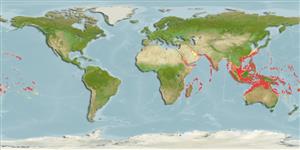>
Scombriformes (Mackerels) >
Scombridae (Mackerels, tunas, bonitos) > Scombrinae
Etymology: Gymnosarda: Greek, gymnos = naked + Greek, sarde = sardine; 1598 (Ref. 45335).
More on author: Rüppell.
Environment: milieu / climate zone / depth range / distribution range
экология
морской ассоциированный с рифами; мигрирует в океане (Ref. 51243); пределы глубины 0 - 250 m (Ref. 86942). Tropical; 20°C - 28°C (Ref. 5313); 31°N - 30°S, 32°E - 130°W (Ref. 168)
Indo-Pacific: Red Sea and East Africa to French Polynesia, north to Japan, south to Australia.
Size / Вес / Возраст
Maturity: Lm ? range ? - ? cm
Max length : 248 cm FL самец/пол неопределен; (Ref. 40637); common length : 190 cm NG самец/пол неопределен; (Ref. 9710); наибольший вес (опубликованные данные): 131.0 kg (Ref. 168)
колючие лучи спинного плавника (общее число) : 13 - 15; членистые (мягкие) лучи спинного плавника (общее число) : 12 - 14; колючие лучи анального плавника: 0; членистые (мягкие) лучи анального плавника: 12 - 13; позвонки: 38. This species is distinguished by the following characters: body elongate and moderately compressed; mouth fairly large, upper jaw reaching to middle of eye; 14 to 31 large, conical teeth on upper jaw, 10 to 24 on lower jaw; 2 patches of villiform teeth on upper surface of tongue; total gill rakers on first gill arch 11-14; D1 XIII-XV, its border almost straight, the second followed by 6-7 finlets, dorsal fins close together; anal fin followed by 6 finlets; pectoral fins with 25-28 rays; interpelvic process large and single; lateral line strongly undulating; body naked posterior to corselet except for lateral line, dorsal-fin base, and caudal keel; caudal peduncle slender, with a well-developed lateral keel between 2 smaller keels on each side. Colour of back and upper sides brilliant blue-black, lower sides and belly silvery; no lines, spots or other markings on body; anterior tip of first dorsal fin dark; other fins greyish (Ref. 9684).
An offshore species found mainly around coral reefs. Generally solitary or occur in small schools of six or less. Preys on small schooling fishes such as Decapterus, Caesio, Nasio, Cirrhilabrus, Pterocaesio and squids. Caught mainly by pole-and-line. Marketed canned and frozen (Ref. 9684, 48637). Adults may be ciguatoxic (Ref. 37816). Minimum depth reported taken from Ref. 128797.
Life cycle and mating behavior
Maturities | размножение | Spawnings | Egg(s) | Fecundities | личинки
Collette, B.B. and C.E. Nauen, 1983. FAO Species Catalogue. Vol. 2. Scombrids of the world. An annotated and illustrated catalogue of tunas, mackerels, bonitos and related species known to date. Rome: FAO. FAO Fish. Synop. 125(2):137 p. (Ref. 168)
Статус Красного Списка МСОП (Ref. 130435)
Угроза для людей
Reports of ciguatera poisoning (Ref. 168)
Использование человеком
рыболовство: не имеет хозяйственного значения; объект спортивного рыболовства: да
дополнительная информация
инструменты
Специальные отчеты
Скачать в формате XML
ресурсы в Интернет
Estimates based on models
Preferred temperature (Ref.
123201): 20.9 - 28.2, mean 26.5 °C (based on 938 cells).
Phylogenetic diversity index (Ref.
82804): PD
50 = 1.0000 [Uniqueness, from 0.5 = low to 2.0 = high].
Bayesian length-weight: a=0.01072 (0.00643 - 0.01784), b=3.06 (2.92 - 3.20), in cm total length, based on LWR estimates for this species & (Sub)family-body (Ref.
93245).
Trophic level (Ref.
69278): 4.5 ±0.75 se; based on food items.
устойчивость к внешним воздействиям (Ref.
120179): низкий, минимальное время удвоения популяции 4.5-14 лет (Assuming tmax>10).
Fishing Vulnerability (Ref.
59153): Very high vulnerability (90 of 100).
Climate Vulnerability (Ref.
125649): Very high vulnerability (92 of 100).
Nutrients (Ref.
124155): Calcium = 11.6 [6.8, 20.1] mg/100g; Iron = 0.539 [0.311, 0.982] mg/100g; Protein = 21.8 [20.2, 23.1] %; Omega3 = 0.136 [0.084, 0.225] g/100g; Selenium = 69.1 [38.3, 127.4] μg/100g; VitaminA = 51.6 [19.1, 151.7] μg/100g; Zinc = 0.543 [0.384, 0.760] mg/100g (wet weight);
